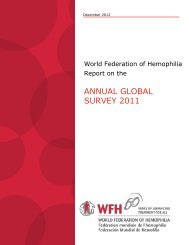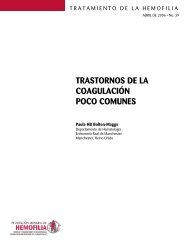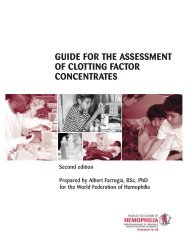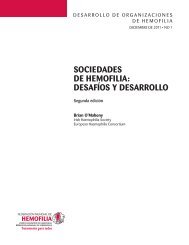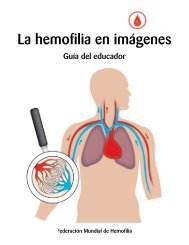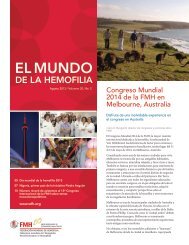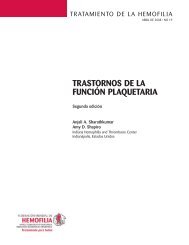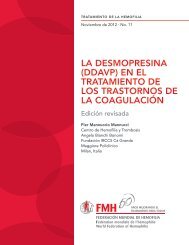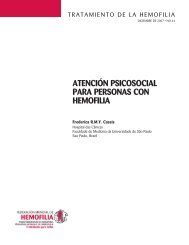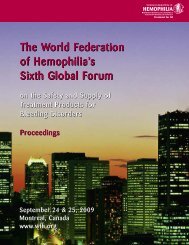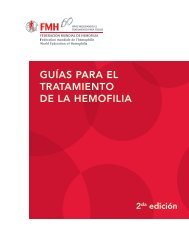Guidelines for Dental Treatment of Patients with Inherited Bleeding ...
Guidelines for Dental Treatment of Patients with Inherited Bleeding ...
Guidelines for Dental Treatment of Patients with Inherited Bleeding ...
You also want an ePaper? Increase the reach of your titles
YUMPU automatically turns print PDFs into web optimized ePapers that Google loves.
<strong>Guidelines</strong> <strong>for</strong> <strong>Dental</strong> <strong>Treatment</strong> <strong>of</strong> <strong>Patients</strong> <strong>with</strong> <strong>Inherited</strong> <strong>Bleeding</strong> Disorders 5hours <strong>for</strong> those patients <strong>with</strong> a mild bleedingtendency whilst those <strong>with</strong> more severeconditions or a history <strong>of</strong> prolonged bleedingdespite hemostatic cover may requiresupervision overnight in hospital. [25]• Discuss treatment requiring theadministration <strong>of</strong> coagulation factor ordesmopressin (DDAVP) <strong>with</strong> thehemophilia unit. They will be responsible<strong>for</strong> arranging the administration andmonitoring <strong>of</strong> treatment products.• Discuss the use <strong>of</strong> local hemostatic agents.This could include the use <strong>of</strong> oxidizedcellulose (Surgicel ® ) or fibrin glue. Fibringlue should not normally be used in patientswho have never received human-derivedblood products or those who are receivingtreatment <strong>with</strong> recombinant factor VIII or IXbecause <strong>of</strong> the potential risks <strong>of</strong> human viraltransmission.• Consider whether to use antibioticsfollowing a dental extraction. This iscontroversial, but there are a number <strong>of</strong>anecdotal reports suggesting that their usemay prevent a late bleed, which is thoughtto be due to infection. However, if a patienthas an infection be<strong>for</strong>e treatment, it shouldbe treated <strong>with</strong> antibiotics.• Always carry out treatment asatraumatically as possible.2. Pre-operative period• Ensure that the oral cavity is as healthy aspossible be<strong>for</strong>e any surgical procedure. Thiscan be achieved by arranging treatment<strong>with</strong> a hygienist to remove as much calculusand plaque as possible. The regular use <strong>of</strong>an antibacterial mouthwash, <strong>for</strong> examplechlorhexidine, may also help.• Consider using an antifibrinolytic agent. Itmay be helpful to start the treatment the daybe<strong>for</strong>e the surgery. Tranexamic acid (usualadult dose 1 g three times a day) and epsilonaminocaproic acid (EACA) (50 mg/kg fourtimes a day), are the most commonly useddrugs. They should be continued <strong>for</strong> a total<strong>of</strong> 7 days.3. Peri-operative period• Have the patient rinse <strong>with</strong> chlorhexidinemouthwash <strong>for</strong> 2 minutes be<strong>for</strong>e theadministration <strong>of</strong> the local anesthetic.• Carry out the extraction out asatraumatically as possible.• Suture the socket if the gingival margins donot oppose well. Brewer [26] reports a smallseries where sutures were not usedroutinely and there was no significantincrease in post-extraction hemorrhage.Resorbable and non-resorbable sutures maybe used at the operator’s discretion. Theonly problem <strong>with</strong> non-resorbable sutures isthe need <strong>for</strong> a post-operative visit and thepossibility <strong>of</strong> bleeding when the suture isremoved.• Use local hemostatic measures if indicated.These include the use <strong>of</strong> oxidized celluloseor fibrin glue (see notes on the use <strong>of</strong> fibringlue).• Use a s<strong>of</strong>t vacuum <strong>for</strong>med splint to protectthe socket if needed.4. Post-operative periodThe patient must be given detailed postoperativeinstructions:• No mouth rinsing <strong>for</strong> 24 hours;• No smoking <strong>for</strong> 24 hours;• S<strong>of</strong>t diet <strong>for</strong> 24 hours;• No strenuous activities <strong>for</strong> 24 hours;• Prescribed medication must be taken asinstructed;• Analgesia should be prescribed <strong>for</strong> use ifrequired;• Salt-water mouthwashes (1 teaspoon <strong>of</strong> saltin a glass <strong>of</strong> warm water) should be usedfour times a day starting the day after theextraction <strong>for</strong> 7 days [27];• Antibacterial mouthwash may be used;• Emergency contact details must be given tothe patient in case <strong>of</strong> problems.Post-extraction hemorrhageCareful pre-operative planning and the use <strong>of</strong>antifibrinolytic agents will prevent many postoperativeproblems [28]. However, postextractionbleeding will occur on occasion. Ifpost-extraction hemorrhage occurs:Contact the hemophilia unit and consider usingadditional factor concentrate.Inspect the site <strong>of</strong> the bleed. If there is anyevidence <strong>of</strong> a tear in the gingiva or otherobvious bleeding point this should be treatedusing local measures as previously described.



